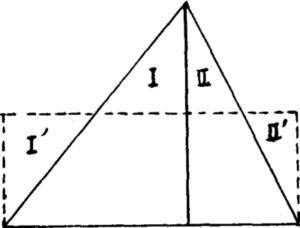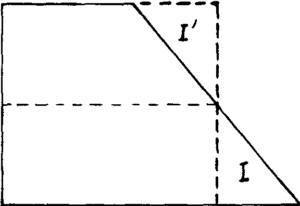Chapter 16 Chapter 4 Area and Volume
A rectangle was called a square field in ancient times, and the area formula proposed in "Nine Chapters" is "multiplying the number of steps of Guangcong to get the accumulated steps".In ancient times, "wide" refers to the length from east to west, and "from [zongzong]" refers to the length to the north, then the area S=ab.Liu Hui did not prove this formula, but gave a definition of area: "The multiplication of Fan Guangcong is called power." The meaning of power is different from today's power.
The triangle is called Guitian. The area algorithm proposed in "Nine Chapters" is "half the width multiplied by the right side". The width is the bottom, and the right side is the height. The formula is S=1/2ah.Liu Hui recorded the proof method of supplementing deficiency with surplus, and patching triangles into rectangles, as shown in Figure 1.Supplementing deficiencies with surplus, also known as supplementing in and out, is one of the main methods in ancient China to solve problems such as area, volume, and Pythagoras.

Figure 1 Guitian's in and out complementation
Right-angled trapezoid, which is called Xie Tian in "Nine Chapters", the calculation formula of its area is S=1/2(a+a)h, where a, a, and h are the upper and lower bases and heights, and they are also patched into rectangles To prove its area, as shown in Figure 2.The general trapezoid is called Jitian, which can be decomposed into two evil fields, and its area formula is the same as above.

Figure 2 Complementary entry and exit of Xietian
Qin Jiushao’s three oblique quadrature technique is a method of calculating the area of the three sides of a known triangle: there is a triangular field today, with 13 li in the small oblique, 14 li in the middle oblique, and 15 li in the large oblique. Combine the large oblique power, subtract the middle oblique power, and multiply the remaining half by itself. Multiply the large oblique power by the small oblique power, subtract the above and the remainder, and the four approximations are real. One is the corner, and the square root is taken to get the product. "(Volume 5 of "Nine Chapters of Shushu") This passage is written in modern symbols:
 The polynomial decomposition factor under the root sign becomes ½(a+b+c)·1/2(a+bc)·1/2(c+ab)·1/2(b+ca).It can be seen that the triclinic quadrature formula is equivalent to the ancient Greek Heron's formula.Qin Jiushao also used the three oblique quadrature method to solve the area of the four different fields.
The polynomial decomposition factor under the root sign becomes ½(a+b+c)·1/2(a+bc)·1/2(c+ab)·1/2(b+ca).It can be seen that the triclinic quadrature formula is equivalent to the ancient Greek Heron's formula.Qin Jiushao also used the three oblique quadrature method to solve the area of the four different fields.

Figure 1 Guitian's in and out complementation

Figure 2 Complementary entry and exit of Xietian

